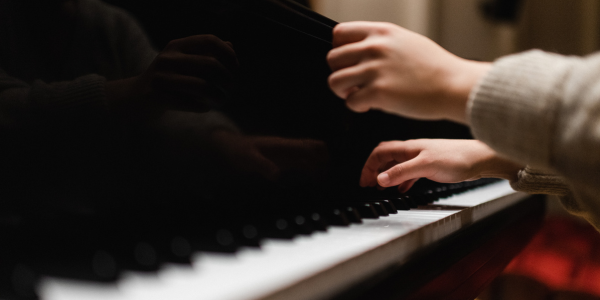We would like to thank Stephen Marquiss for this article on Abby Whiteside. Interested in learning more about Whiteside? Attend this session at The Piano Conference: NCKP 2025 online event on Saturday, June 7, 2025, 1:30-1:55pm CDT. Learn more and register for the conference here.

1. Abby Whiteside (1881-1956) transformed her teaching after admitting only her talented students progressed.
She was history’s humblest piano teacher. This realisation kickstarted a lifetime of open-minded exploration. Whiteside became determined that, given the best tools, the less gifted could play as well as the most talented. She left essays which, whilst brilliant and beautiful, some perceive to be disjointed or abstruse in places. This could be because she continued to revise and refine her ideas literally until her deathbed. It could also be because her audacious innovations present a serious challenge to pedagogical orthodoxy.
2. Whiteside devised ingenious, unorthodox tools so that all could play.
She identified central tenets in technique, common in the most talented players, which were often overlooked in conventional pedagogy. Chief amongst these are the roles of the upper arm, torso, ears and emotional connection. She was openly critical of any aspects of technical orthodoxy that neglected these. She believed that the fingers must cede control of power and dexterity to the larger levers, the torso and the ears. She devised many ‘set-ups,’ ‘patterns,’ and activities, such as ‘splashing’ on random keys and improvising, to empower all pianists to play to their potential.
3. Whiteside tested her tools on Chopin’s most notorious études.
She believed these were the ultimate barometer of technique, owing to their idiosyncratic repeated patterns and figurations. If anything impedes the technique, one can barely complete a few bars without tensing up unduly. Whiteside highlighted elephants in the practice room such as the common practice of isolating the hands and fingers from the flowing whole-body coordination and of trying to attain virtuosity without the crucial role of emotional engagement. She believed many to be practising essentially irrelevant coordination. Her tools focus on rebuilding more instinctive, ergonomic practice habits.

4. Inspired by dance, Whiteside centralized the ‘emotional rhythm’ in technique.
She coined this term for the flowing state invoked by the performer’s authentic connection to the music, combined with the activity this awakens in the torso. Such activity could be overt swaying or ‘bouncing’ against the sitting bones or simple alertness, as in the tennis player receiving a serve or the ‘athletic tension’ between dancers. She believed attempting to attain velocity and exquisite musical control without activating this central component was akin to trying to perfect swimming technique by playing golf.
5. Inspired by jazz, Whiteside prioritized playing by ear.
She believed this invoked a simpler, more direct, efficient coordination than playing predominantly by sight, rote, or ‘muscle/motor’ memory. Without the middleman of the score, the fingers are directed economically by the ‘aural image’ of the music in the mind’s ear. A central aim in practice thus becomes to take the music ‘off the page’ when starting with the score, such that one can hum it in the inner ear. This can be a journey for pianists who have become accustomed to pushing down keys in response to primarily visual cues, although the rewards are great.
MORE ON THE PIANO CONFERENCE: NCKP 2025
- THE PIANO CONFERENCE: NCKP 2025
- PIANO MAGAZINE: Some reflections on the 2005 National Conference on Keyboard Pedagogy (NCKP) by Elvina Truman Pearce
- WEBINAR: NCKP 2023 Committee Webinar: How to Practice Jazz and Improvisation with Jeremy Siskind
- WEBINAR: Teaching Demonstration (NCKP Rebroadcast) with Marvin Blickenstaff
- DISCOVERY PAGE: The Benefits of NCKP: The Piano Conference and Why You Should Attend by Marvin Blickenstaff
- DISCOVERY PAGE: What to Expect at The Piano Conference: NCKP 2025: From the Inclusive Teaching Track and Keyboard Lab Presentations by Derek Kealii Polischuk and Sara Ernst
- DISCOVERY PAGE: What to Expect at The Piano Conference: NCKP 2025: From the Technology and New Professionals Tracks by Stella Sick and Allison Shinnick Keep
- DISCOVERY PAGE: What to Expect at The Piano Conference: NCKP 2025: From the International Track by Luis Sanchez
- DISCOVERY PAGE: What to Expect at The Piano Conference: NCKP 2025: From the Collaborative Performance and Research Committee Chairs by Sara Ernst, Alexandra Nguyen, and Alejandro Cremaschi
- DISCOVERY PAGE: What to Expect at The Piano Conference: NCKP 2025: From the Performance Practice, Teaching Adults, and Business & Entrepreneurship Committee Chairs by Sara Ernst, Andrew Cooperstock, Jackie Edwards-Henry, and Andy Villemez
- DISCOVERY PAGE: What to Expect at The Piano Conference: NCKP 2025: From the Creative Music Making, Independent Studio Teachers, and Young Musicians Committee Chairs by Sara Ernst, Jason Sifford, Janet Tschida, and Jeremy Siskind
- DISCOVERY PAGE: What’s New at The Piano Conference: NCKP 2025 by Sara Ernst, Michaela Boros, and Megan Hall
- WEBINAR: NCKP 2023 Committee Webinar: Facing the Future with Jason Sifford